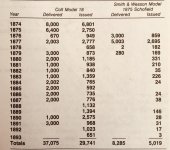- Joined
- Dec 1, 2022
- Messages
- 886
- Reaction score
- 1,433
Hi There,
My measurements are close but not the same. Now, my cylinder
assembly measures 1.632" from the ratchet teeth to the end of
the extractor. If I measure from the pin in the center of the
ratchet to the other end, I get 2.688"
Cheers!
Webb
Today. Measured distance from teeth (in star of extractor) to end of ejector rod & I come up with 2.677 in. From front of cylinder to end of extractor rod is 1 inch. From front of cylinder (excluding the collar on the front) I get 1.145 or 1 1/8th inch. Ordered a replacement extractor from Popperts. Other than that, no progress.
My measurements are close but not the same. Now, my cylinder
assembly measures 1.632" from the ratchet teeth to the end of
the extractor. If I measure from the pin in the center of the
ratchet to the other end, I get 2.688"
Cheers!
Webb

